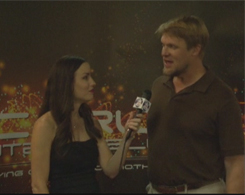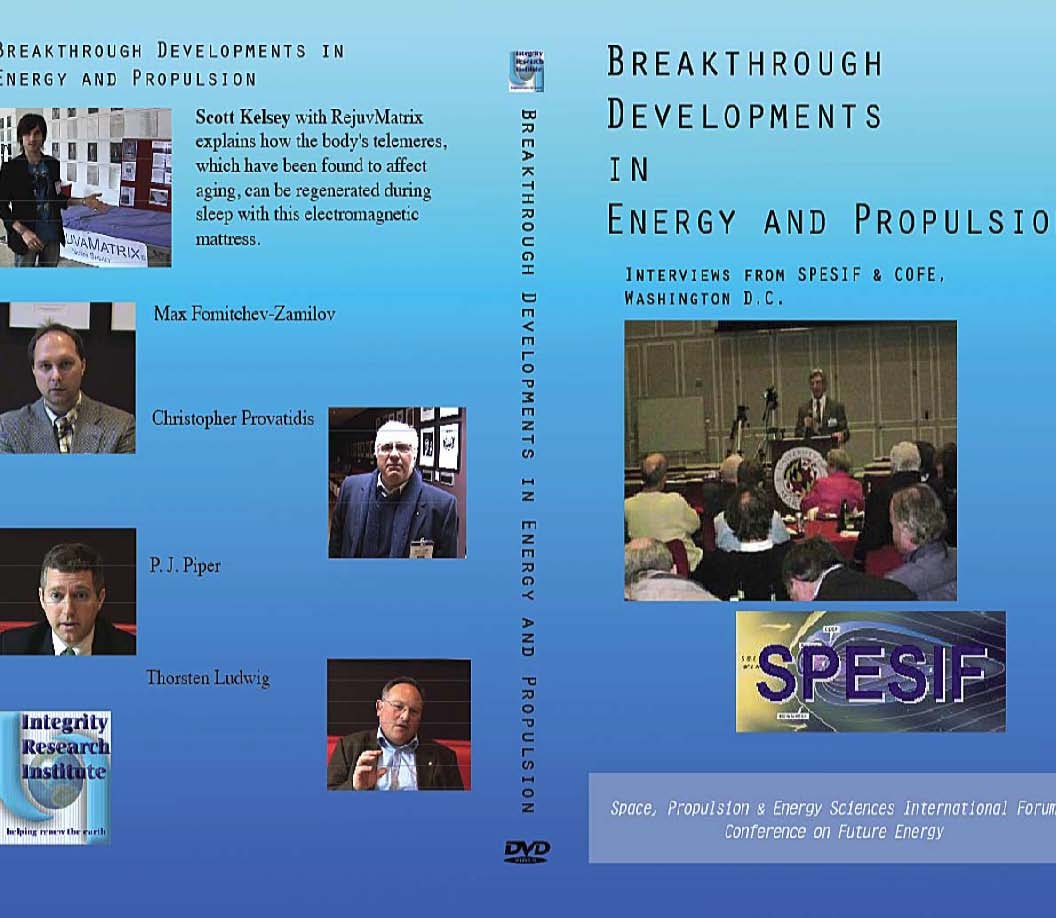|
|
|
Greetings!
We
are happy to give you the details of all of the confirmed and invited
speakers for the upcoming Conference on
Future Energy in the first story this
month. It should be an exciting two day event with demonstrations as
well as exhibits. Furthermore, the full conference registration fee
is only $150 or $80 per day. Students with ID are FREE and
registering for COFE6 also gives one admission to the concurrent
Natural Philosophy Alliance presentations that are next door at the
Stamp Student Union. Banquet fee for Friday night
is only $35 and NPA will be selling a softcover edition of the
Proceedings for only $35. Hope you can join us!
How
about a cheap battery that's also designed to last 30 years? That's
the promise of our second story with the battery made from zinc,
water and air. EOS Energy Storage hopes to help the wind turbine
industry with rechargeable metal-air batteries.
Our
third story has a wonderful artistic rendering of the world's most
indefatigable reporter, Jeane Manning, author of Breakthrough
Power (Amber Bridge Books) who has now
tackled the Defkalion Green Technologies Hyperion LENR thermal
generator right in her home town of Vancouver BC. She reports it
producing 5 kW of thermal energy and a planned 45 kW generator.
The
fourth story is very exciting since it involves threads that have
both a solar cell and a piezoelectric generator combined together. A
picture shows Dr. Wang from Georgia Tech holding the nanogenerator
thread glued to a Plexiglas plate with leads
attached. It's amazing to see two forms of electricity generation
merged into one tiny module so that electric clothing will become
chargers, biomonitors, and as IRI believes, antioxidant providers for
the wearer.
We
are not the only group promoting quantum vacuum propulsion. Dr.
Gerald Cleaver, physics professor at Baylor University, is
interviewed in our final story five with his version of antimatter
propulsion. Of course, attending the Conference in
Interstellar Flight might also be worthwhile as well.
Lastly,
we also would like to let you know about the 2013
Extraordinary Technology conference to be held in
Albuquerque NM on July 24-28, 2013, If you join IRI this
month, we are sending new IRI Members a copy of our last
Annual Report mailing, the 16-page Extraordinary Technology conference
magazine and as a special FREE bonus, the latest issue ofExtraOrdinary
Science & Technology (Jan-Mar., 2013), a 65-page
magazine that is a FULL COLOR first
and a collector's item because it has articles on
the Papp engine, Tensor Ring, Torsion, and also contains a lengthy,
profusely illustrated article by Dr. Jacqueline Panting, ND and
myself on "Tesla's Electrotherapy for Health and Healing".
This month we are announcing the
Inner Traditions publisher's release of Infinite
Energy Technologies edited by Finley
Eversole, PhD. It has a chapter on "Zero Point Energy Can Power
the Future" contributed by Valone and other biographical
chapters on T. Townsend Brown, Royal Raymond Rife, John Worrell
Keely, Victor Schauberger, Nikola Tesla and John R.R. Searl, all who
still hold the public's fascination for their energy and bioenergy
breakthroughs. The book also has survey chapters on cold fusion, free
energy, and sustainable technologies. It is also sale priced at
$16.00.
Sincerely,
Thomas
Valone, PhD, PE.
Editor
|
|
|
QUICK LINKS
|
|

COFE RESERVATIONS LINK
LIKE US ON FACEBOOK AND GET
10% OFF ANY ITEM IN OUR CATALOG!
 
|
|
|
1)
Renewable and Non-Conventional
Energy Technology at COFE6
|
Integrity Research Institute Press Release
June 2013
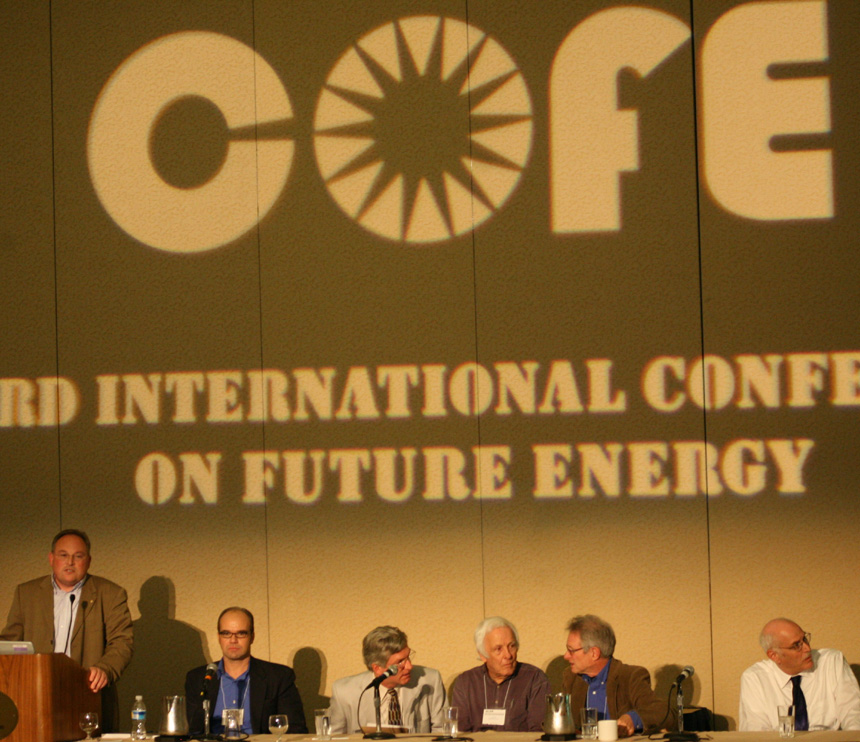
June 18, 2013 - Washington DC. Upcoming Sixth
Conference on Future Energy (COFE6) www.futurenergy.org
is shaping up at the University of Maryland with a list of cutting
edge energy developments that are unique to the IRI approach to
public education. Our plenary speaker, Dr. Max Fomitchev-Zamilov is
from Penn State University who will be presenting a talk on and demonstration
of experimental
cavitation fusion that can power the future with his
cavitation reactor pictured here. 
We
have confirmed Ben Matek from the Geothermal Energy Association and
John Finnerty from Standard Solar for conference presentations. Jim
Dunn who is a former CEO of NASA's Center for Technology
Commercialization will also be presenting his latest assessment of
energy developments. Francis McCabe is on the program to summarize
his research into Gyro and Inertial Propulsion, which caused a
shudder last year when anengineer from
Boeing announced at COFE5 that many aerospace
industries are using gyroscopic inertial propulsion on satellites.
Dr. Thorsten Ludwig from Germany will present his latest findings on
the Coler magnetic current apparatus. Dr. George Miley is
scheduled to remotely present his life story of the fusion research
he performed everywhere in the world, which is also the subject of
his autobiography just published. Russ Gries, who just published an
amazing article on the Josef Papp engine, and Matt Emery, who is an
expert from www.Leedskalnin.com(Coral
Castle), have both been invited to present a summary of their work
and exhibit their findings. We also welcome Sterling Allan, Founder
and CEO of Pure Energy Systems, to remotely present his summary of
five top emerging energy technologies nearing the market.
To
continue with our schedule, Dave Fournier has been invited to talk
and demonstrate his magnetic motors which he claims need no external
electrical input. Dr. Thorsten Ludwig will return from Germany to
present his latest experimental findings on a current generator
experiment and Frank Amador has been invited to summarize his
research into the anomalous Otis Carr "amusement device"
patent which apparently has classified documents associated with it.
We are pleased to have Nick Simos from Brookhaven National Labs
present his amazing classical physics analysis of Nikola Tesla's
wireless transmission of electrical power which gives it a high
feasibility rating. Also, Dave Froning will compliment Dr. Max with
his prerecorded slide presentation on electromagnetic confinement for
nuclear fusion. Of course, as a backup speaker, I have the privilege
of presenting a talk on High Voltage Electrotherapy if there is a
vacancy.
|
2)
Thirty Year Battery That Can Replace Natural Gas Plants
|
Technology Review, June 10, 2013
http://www.technologyreview.com/news/515076/cheap-batteries-for-backup-renewable-energy/?utm_campaign=newsletters&utm_source=newsletter-weekly-energy&utm_medium=email&utm_content=20130610
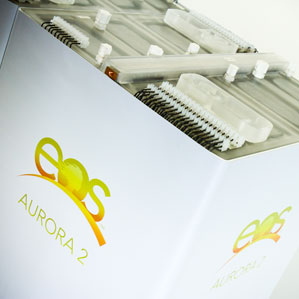
Investors
recently chipped in $15 million to fund battery startup EOS Energy Storage, a company that
says its batteries could eventually compete with natural-gas power
plants to provide power during times of peak demand.
Cheap
energy storage is becoming increasingly important as greater numbers
of wind turbines and solar panels are added to the grid. If renewable
energy is to replace the fossil fuels that dominate power supplies
and serve to backup wind turbines and solar panels, very large-scale,
inexpensive batteries like the ones EOS is developing will be needed
(see "Wind Turbines, Battery Included, Can Keep
Power Supplies Stable," "Battery Could Provide a Cheap Way to Store
Solar Power," and "A Solution to Solar Power Intermittency").
EOS
is trying to commercialize a type of battery that's based on
inexpensive materials: water, zinc, and air (see "Startup Promises a Revolutionary Grid
Battery" and "Years in the Making, Promising
Rechargeable Metal-Air Batteries Head to Market"). Such
batteries-in which zinc reacts with oxygen in air to generate
electricity-have been around for a long time, but it's been difficult
to make them rechargeable. Electrodes deteriorate, for example, and
the batteries are inherently inefficient because of the difference in
voltage levels when charging and discharging them-they waste nearly
half the energy it takes to charge them.
EOS
has addressed these issues in a couple of ways. It uses a slightly
acidic water-based electrolyte that helps prevent deformations of the
zinc electrode that can damage the battery.
The
company is also supplementing the zinc-oxygen reaction with reactions
between zinc and a mixture of up to six other materials (it won't
identify the type of compounds). The other reactions help reduce the
difference between charge and discharge voltages, improving the
efficiency from 60 percent to almost 75 percent. The mixture of
reactions makes the battery more difficult to operate, but George Adamson, vice president of
R&D, says that today's battery management software is up to the
task.
The
decision to make use of these extra reactions was the result of a bit
of serendipity. Impurities were causing unwanted side reactions in
the original zinc-air prototypes. But then the researchers noticed
the beneficial impact on voltage. "Once we realized that,"
Adamson says, "we started searching on purpose for multiple
combinations of reactions."
EOS
has built a two-kilowatt prototype. Eventually, its batteries will be
packaged inside a shipping container to make one-megawatt batteries
than can store six megawatt-hours of electricity, enough to power a
typical U.S. home for six months. It plans to build a pilot
manufacturing plant by the end of the year or early next year, and to
start making full-size one-megawatt batteries by the end of 2014.
EOS
wants to produce batteries that cost as little as $160 per
kilowatt-hour and last for 30 years. Current batteries that cheap
would fail after only a couple of years of service. The U.S.
Department of Energy has set a goal of batteries at $100 per kilowatt-hour
that can be recharged 5,000 times with 80 percent efficiency, saying
that at that point batteries could be widely adopted for grid
storage. EOS says its batteries can last 10,000 charges, which could
make up for the higher upfront cost and lower efficiency of its
batteries.
But
the company hasn't reached its goals yet. It says it's "well
within" $300 per kilowatt-hour. EOS has completely charged and
discharged the most recent iteration of its battery cells over 1,000
times, and the batteries have so far retained 90 percent of their
capacity. Typically, batteries are designed to retain 80 percent of
their capacity at the end of their life, so the current rate of
capacity loss is too fast for a 10,000-cycle battery.
But,
Adamson says, much of the capacity loss is from electrolyte levels
falling too low. In one experiment, topping off the batteries
restored capacity from 80 percent to 96 percent of the original
capacity. Manufactured batteries will come with a mechanism for
automatically topping off the electrolyte, which could improve the
durability of the system.
EOS
says it's teaming up with seven utility companies to test the battery
and design it to the performance specifications they need-it will
announce the partners in the next couple of weeks.
|
3) Jeane Manning's report on Live Demo of
Defkalion
|
Cold Fusion Now
May 2013
Jeane
Manning, author of Breakthrough Power, has published an
article in Atlantic Rising on her visit to Defkalion Green Technologies new
office in Vancouver, Canada where she viewed a live
demonstration of their Hyperion thermal generator.

Beyond
LENR (aka 'cold fusion') to Useful Energy [.pdf] is available for free on
Manning's Changing Power website and
describes a generator capable of producing 5 kilowatts of thermal
power, with "several times" energy output.
A
planned 45 kilowatt generator will be comprised of nine units in
parallel. A test generator in Greece is claimed to run
continuously for six months producing power at 45 kilowatts.
Preferring to call the reaction Heat Energy Nuclei Interactions(HENI),
the thermal energy was generated on just 3 grams of nickel powder and
2 liters of hydrogen.
The
company moved to Vancouver "after their government
failed to help the start-up
company." Canada "offered a stable environment
for research-and-development companies, with a support network and
fiscal incentives." Additional labs
in Athens,Milan, Italy as well
as Brazil will be developing applications with multiple
business partners.
Initially
a partner with Andrea Rossi, Defkalion and Rossi split after
differences arose over contractual issues. Deciding to develop a
generator on their own, the company began with the premise that only
after achieving stability and control would they scale up to high
heat output.
The
article quotes Peter Gluck, a chemist and longtime low-energy
nuclear reactions (LENR) researcher. "Cold fusion came
before its time. It is too complex, too new, too unexpected, too
messy, too multifaceted, too dynamic, too non-linear and too weird to
be really understood and controlled at the time of its
discovery."
Defkalion's
Chief Technical Officer John Hadjichristos
responded
"Science is one, and we have to keep it that way if we want to
keep on talking with Mother Nature ...We cannot see or listen and
understand her stories if we stop talking to and hearing each
other."
RELATED
NEWS
HotCat Independent Report May 20, 2013
The long-promised report
on the HotCat has arrived. Far too early to draw conclusions, I have
to admit to being surprised. Never have I longed to be proven wrong
so much in my life. We are not there yet, but at face value, this
appears to be a giant step in the right direction. Healthy scepticism
of the scientific kind is still advised since there are, as yet, many
unanswered questions. However, extreme sceptics cannot assume that
Rossi is hiding the rabbit by micro-managing the tests. They are
right to ask questions but they can no longer say that we are talking
about a small, easily miss-measured effect, that the testers are
idiots or that they have remained silent due to extreme
embarrassment. Among them, Hanno Essen and Giuseppe Levi have much to
lose amid a controversy fit for the 21st century. They know the
impact of their conclusions and it is difficult to see how they could
be substantially wrong.
Successful
runs producing COPs of 5.6 and 2.6 were conducted (while running the
device without the charge in place did not result in anomalous heat).
At around four days continuous operation, short of illicit nocturnal
recharges, it is difficult to see where the report writers could have
made a mistake.
The
report authors include working physicists, chemists and a radiation
expert:
back to table of contents
|
4) Using Nanotechnology to
Capture the Energy Around Us
|
|
Yale Scientific Magazine, May 11th, 2013
http://www.yalescientific.org/2013/05/electricity-from-thin-air-using-nanotechnology-to-capture-the-energy-around-us/
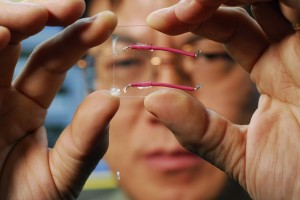
Energy
exists all around us - in the motion of a heartbeat, the fluorescent
light in an office building, and even the flow of blood cells through
the body. These individual units of energy are relatively small, but
they are numerous.
Dr.
Zhong Lin Wang, Professor of Materials Science and Engineering at the
Georgia Institute of Technology, has developed a way to harness this
ambient energy. After months of work, Wang and his team have
developed the very first hybrid cell, which is capable of harnessing
both motion and sunlight. By tapping into multiple sources of readily
available energy, the tiny cells have the potential to revolutionize
the way we power our devices.
Since
Wang's cell is small enough to work on the nanoscale, it can readily
be incorporated into biomedical sensors, cellphones, and other small
electronics. The cell's hybrid design is an advantage as well: Solar
energy alone produces high voltages but is unsuitable for devices
used in the dark, while energy from ambient motion is more consistent
but is available on a smaller scale. By combining these sources,
Wang's device can provide a highly reliable supply of electricity.
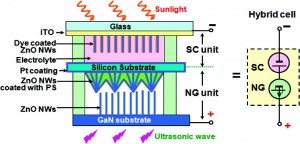
Wang
developed the motion-harnessing component of the hybrid cell in 2006.
These devices, called nanogenerators, can collect energy at the
micro- and nanoscales of motion by relying on piezoelectricity, the
production of a current from compression or strain. To construct a
nanogenerator, Wang grew a vertical array of microscopic zinc oxide
(ZnO) wires on a flat base. On top of this, he placed an electrode
with multiple pointed peaks that give it a "zig-zag"
appearance. When the ZnO nanowires are bent out of their ordered formation,
they generate small electric charges due to piezoelectricity. They
then touch the zig-zag edge of the electrode, which collects all the
electricity to produce a current. Due to its sensitivity, a
nanogenerator can capture even vibrations of very small magnitudes,
which can then be harnessed to power an object such as a
pacemaker. In fact, nearly a milliwatt of mechanical energy
exists in each cubic centimeter of the ambient environment.
Many
devices, however, cannot be sustainably powered by nanogenerators
alone; solar cells generate a larger voltage more practical for use
in bright environments. To miniaturize solar power capture, Wang made
use of an existing technology called a dye-sensitized solar cell
(DSSC). These cells are made by combining an anode with an
electrolyte solution to form a semiconductor. First, a dye is applied
to the anode to make it sensitive to light. When light strikes the
dye, it releases electrons that flow through the anode toward the
electrolyte solution, generating a current. Wang's method employs the
same principle on a miniaturized scale. Dye-coated ZnO nanowires
serve as the anode, surrounded by the cell with a chamber of
electrolytic fluid, forming a DSSC small enough to integrate with a
nanogenerator.
After
refining both technologies in collaboration with Dr. Xudong Wang of
the University of Wisconsin-Madison, Wang has discovered a way to
incorporate both nanogenerators and DSSCs into a device he terms a
"hybrid cell." The upper layer of the cell harvests light energy,
and the nanogenerator below collects ambient motion. A single layer
of silicon is sandwiched between the two and functions as an
electrode for both devices, combining their energy into a single
output. The two sources can be connected in parallel for higher currents
and in series for higher voltages.
For
balance of article, go to YaleScientific.org
back to table of contents
|
|
5) Quantum Vacuum Production of Antiparticles
in situ For Propulsion
|
|
|
About Integrity Research Institute
Future Energy eNews is
provided as a public service from Integrity Research Institute,
a Non-Profit dedicated to educating the public on eco-friendly
emerging energy technologies.
FREE copy
of the 30 minute DVD "Progress in Future Energy" is
available by sending an email with
"Free DVD" in subject and mailing address in
body.
Your generous support is
welcome by making a tax deductible donation on
our secure website
|
|
|
|
- Scott Kelsey, Missouri State, explaining Rejuvamatrix, Pulsed EMF
therapy to increase the length of DNA telomeres, which directly
affect our lifespan.
- Max Formitchev-Zamilov, Penn State, discussing Cavitation Induced
Fusion, that will soon provide power generation and heat
production.
- Christopher Provaditis, from Greece, explaining Inertial
Propulsion and who teamed up recently with Boeing for their space
satellites.
- PJ Piper of QM Power, discussing the motor invented by
Charles Flynn, with a revolutionary parallel path that gives
double and triple efficiency.
- Dr Thorsten Ludwig from Germany (GASE) discussing
the mysterious Hans Coler motor that WWII British Intelligence
researched.
|
|
|
|
|
|
![]()


















